My mother-in-law has a beautiful nativity set that looks like it’s made of ivory. The off-white figures have realistic body proportions and they look expensive. The set is actually made of plastic. She lets toddlers play with it. I wanted a similar nativity for my children to play with: both beautiful and durable. I looked for a couple of years, but never found anything appropriate for kids other than the Fisher-Price Little People set, and that just didn’t check my “beautiful” box.
I turned to Pinterest and made my own nativity from little wooden figurines. It had all the standard figures: Mary, Joseph, and baby Jesus, of course. A shepherd and his boy. Three wise men. A donkey, a camel, some sheep. I made the angel female so Mary wouldn’t be the only girl for my girls to play with. The angel that appeared to the shepherds wasn’t gendered, although the angel Gabriel (who appeared to Zacharias and Mary in Luke 1) is male.
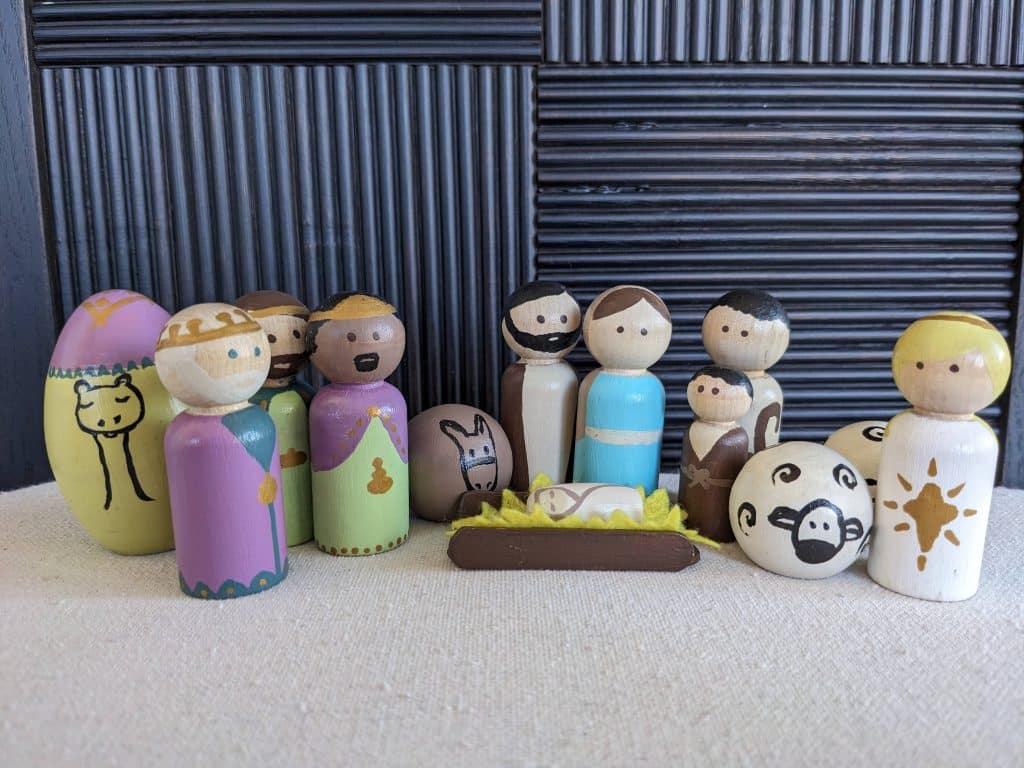
The last few years I’ve absorbed more ideas about the nativity:
- Linguistically, ‘shepherds’ can include ‘shepherdesses’, and ‘wise men’ can include ‘wise women’.
- There wasn’t an innkeeper that turns the couple away, Luke just says “there was no room for them in the inn”. It could just as well been a woman that lead them to the stable as a suitable (if humble) place to give birth.
- Brian Kershisnik’s Nativity painting opened my eyes to the idea that midwives could have attended the birth.
I didn’t save the references to all those ideas, but they’ve stuck in my mind.
At some point we were given a flannel board nativity. The felt pieces had to be carefully cut out. There were more pieces than usual: the wise men’s gifts were separate pieces, and there were chickens and chicks for the stable. There were doves. My four-year-old asked me why there were doves. I had to think for a moment before telling her about how Mary and Joseph took Jesus to the temple to offer doves for a sacrifice. I told her about Simeon being promised he would see Christ before he died, and Anna who was a very old prophetess. My four-year-old, who had recently learned that people’s bodies shrink when they get old, made up this song and sang it for a solid half an hour:
(to the tune of Once There Was a Snowman) Annie was a prophetess, prophetess, prophetess, Annie was a prophetess: tall, tall, tall! When she gotted older, older, older: When she gotted older: small, small, small.
I suppose “became” instead of “gotted” would standardize her adorably immature English. I have come to recognize that the sense of this song is a metaphor for how we currently treat her story in the nativity. Anna was acknowledged in New Testament times as a sage prophetess. As the story’s gotten older, her part in the telling has shrunk. I don’t know why we prioritize the wise men part of the nativity when it happened so much later after Jesus’ birth.
My seven-year-old found some beads that she decided would be the perfect size for adding some lambs to our nativity. She kept track of those beads for months and told me repeatedly what she wanted. When I finally got around to it, I decided to make some new human figures too. I added Anna, Simeon, a woman carrying a pot, a woman carrying blankets, a woman I intended to be a midwife (but she ended up looking young, so maybe she’s the midwife’s apprentice or the shepherd’s teenage daughter and one of the other women is the midwife), a female shepherd, two girls, and three lambs.
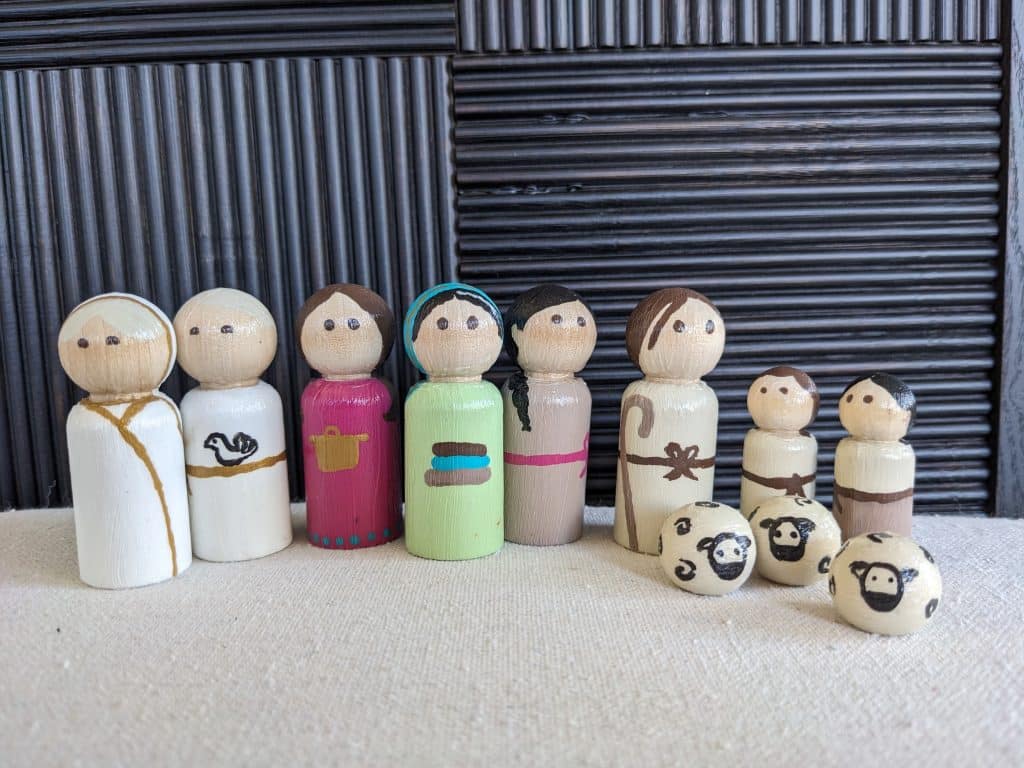
As I was finishing the new pieces, my daughter requested figures for Mary and Martha also. I suggested maybe the woman with the pot could be Martha and she could pretend that one of the other women is Mary. As she’s played, my daughter has also turned these figures into Mary’s mother (Jesus’ grandma) and Elizabeth. Simply having unnamed female figurines has allowed her to play with scripture stories in new ways.
I like how my expanded nativity set makes women’s presence visible. I love that a wide range of women’s ages are represented. It makes my heart full to see a balanced gender representation. My daughter is learning the song “Picture a Christmas” in Primary this year. I wrote two more verses that add women into the picture. I wish I had grown up learning songs about female prophets from the scriptures. The first verse below is all from my imagination, but the second one is supported by the account in Luke every bit as much as the verses currently in the Children’s Songbook.
Picture a calm and caring midwife, Picture a warm, nutritious meal, And women spread a straw-filled bed for time and space to heal. Picture Simeon and Anna, Picture the temple and the doves And with great cheer the ancient seers proclaim God’s saving love.


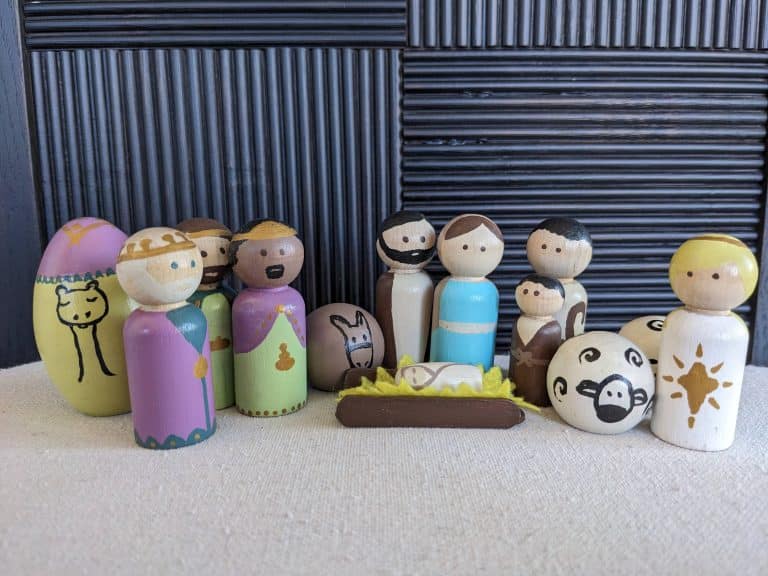
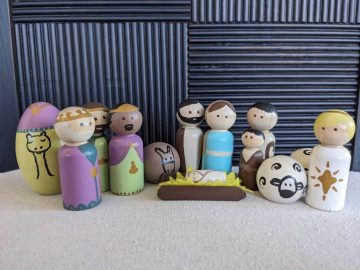
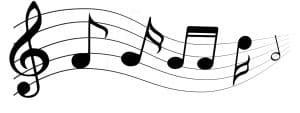

14 Responses
This is lovely! My kids are too old to play with a nativity set, but I want to make one like yours so I can have more women to look at and think about. And I love your extra verses to the song. Thank you!
I love that you’ve added Anna the Prophetess! My teenage daughter is named Anna, and part of the reason I chose that name was because of that story (that nobody ever seems to know). ♥️
How cool to name your child after her! I don’t think I noticed the story until…I was a grown up?
We really do ignore women in this church. I was 17 before I knew about the prophetess Anna at the temple. But, Simon, yeah I had heard a lot about him. So obvious that we Mormons purposely leave women out of the story because the Bible treats Simon and Anna pretty equally. Why do we pretend that women can never be important?
According to tradition, Mary’s mother is also named Anna. I have wondered if perhaps Mary’s mother was the prophetess working at the temple, but probably not because Mary grew up in Nazareth and the temple was in Jerusalem. But women often did things like go to work at the temple when they were widowed, so it is a possibility.
But, I vote for Grandma Anna and prophetess Anna both at the nativity, one with gray hair and one with wispy white hair. The world needs more Annas.
Signed, Anna
I love all the Anna’s (and Anna-adjacent people) that are loving on this post! I’ve never heard that Mary’s mother might have been named Anna. It’s fun to think about and wonder.
I don’t remember hearing much about Simeon either, so my sense has always been that Mormons are just like other Christians in leaving out this part of the story. I don’t think I’ve ever seen another Nativity set that includes them. Do the wise men get all the glory because it’s an excuse for consumerism?
I figure it was a status importance bid.
– They came from far away “with the good stuff” that they gave to Jesus’s family.
Because they gave gold, and rare religious spices, it kinda signals the nobility, outsiders, and priest classes follow (should follow) Jesus. It would be a shame to ruin all those bona fides with a woman, so they didn’t.
I remember feeling really upset that in the church bible video of Mary and Joseph taking Jesus to the temple, we see Simeon, and that’s it! Someone clearly felt it was unnecessary to go on and include Anna’s testimony.
Ooof. I hadn’t noticed that.
I just looked at my handcrafted Mexican pottery nativity set. Equal number of adult men and women. The only shepherd is female, and a girl is kneeling with a gift, with the angel, and Mary equals the Wise Men and Joseph. For sure it was made by Catholics. They are all Hispanic, except the traditionally black Wise Man. At least they are dark skinned, more like the people of the country where Jesus lived, and not Norwegian looking.
That sounds like a lovely set! My original set has a token Black person. I made a few sets for friends, and I didn’t repeat the blonde angel. All the new pieces in my set got wood colored skin just because I wasn’t sure if I would have time for extra layers of paint to dry before I needed to use that space for something else. We have a nativity picture book where all the people are Black, and that’s led to some good discussions about how Jesus might have actually looked. I’m sure I’m not teaching things perfectly, but I’m glad we’re having conversations.
I intentionally made headscarves optional; a personal choice. My daughter complained that Simeon needed a beard, which feels right to me. She also thinks they need mouths and hands, which is totally understandable, but seems rather artistically tricky to me. I’m sure I’d make different artistic decisions if I were to do it all over again. I think this is part of why people love nativity sets–all the variations of ways to tell the same story.
I love those extra verses for the primary song! I’m going yo share them with our primary chorister.
Yay!
Have you read the apocryphal Book of James and the story of Salome, Mary’s midwife? Maybe you will make one of your peg dolls “Salome”.
I have been searching for shepherdesses or midwives in nativity sets for years, they are so difficult to find. The Willow Tree set (with white-clothed faceless people) has a few female angels and attendants.
The LDS books “Women of the old Testament” and “Women of the New Testament” by Camille Fronk Olsen (BYU prof) mention the history and role of midwives in Judea and the overwhelming likelihood (even if traveling), midwives attended Mary’s birth.
If you are looking for some Christmas music to accompany your female-inclusive nativity, play the French carol “Bring a Torch Janette, Isabella!”. The lyrics tell of women who hear of Mary and Jesus in the stable and rush to help them, witnessing to other farmers/shepherds to come too.
I have not read the Gospel of James, but my library has an ebook 😀
Camille Fronk Olsen’s books are just beautiful.
I have a Janette in my life and somehow I wasn’t aware of that song! Thank you!